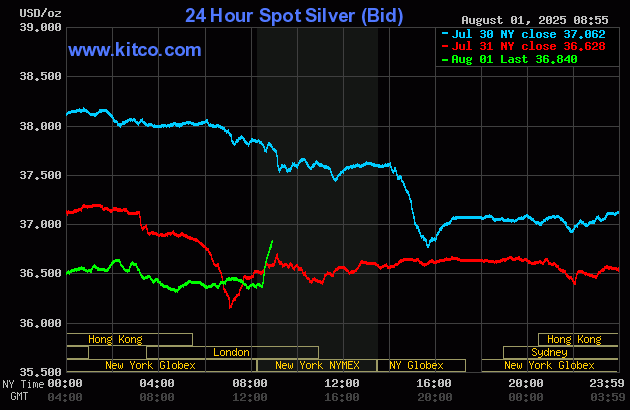
(Kitco News) – Gold prices are sharply higher in early U.S. trading Friday, following a very downbeat U.S. economic report that fell squarely into the camp of the monetary policy doves. December gold was last up $48.60 at $3,397.20. September silver prices were last up $0.243 at $36.955.
Arguably the most important U.S. data point of the month saw the employment situation report for July from the Labor Department come in much weaker than expected. The key U.S. non-farm payrolls number came in at up 73,000 versus expectations for a rise of around 100,000 jobs. The unemployment rate rose slightly to 4.2% from 4.1% in the June report. Importantly, revisions to the May and June reports showed 258,000 fewer job gains. That makes the 73,000 gain for July look all the more weaker. The marketplace now sees a 75% chance for a Fed rate cut at the September FOMC meeting. “Friday’s report is very important, but more than the payroll number, I think we will be focused on the unemployment rate,” said Priya Misra, portfolio manager at JP Morgan. For the Fed to cut interest rates in September, there needs to be clear evidence of the weakening in the labor market, said Misra in a Bloomberg story out before the jobs report was released. Such now appears to be the case.
In other news, President Trump late Thursday unveiled a batch of new tariffs on dozens of countries just ahead of the Aug. 1 U.S.-imposed deadline for new deals to be made. The baseline rates for many countries remain unchanged at 10% from the duties Trump imposed in April. Altogether, the average U.S. tariff rate will rise to 15.2% if rates are implemented as announced, according to Bloomberg Economics. That’s up from 13.3% earlier. Most of the tariffs will take effect on Aug. 7. Bloomberg Economics said Canada and Mexico are “well placed to weather the storm” thanks to carve-outs for goods compliant with the USMCA trade deal. Thursday’s new tariffs didn’t apply to China. Trump will decide whether to extend a tariff truce with China after talks with the U.S. wrapped in Stockholm, Sweden earlier this week.
President Trump’s sweeping new import tariffs are prompting keener risk aversion across world stock and financial markets on this first day of the month. Europe’s Stoxx 600 fell more than 1% to a one-month low. The MSCI All Country World Index slid 0.3%. South Korean shares tumbled the most since early April. Hong Kong’s Hang Seng index fell 1.1% Friday, for the fourth session in a row of losses and hitting a two-week low. China’s Shanghai Composite fell 0.37%, while the Shenzhen Component lost 0.17% on Friday. Japan’s Nikkei 225 dropped 0.66%, bringing its weekly loss to 1.58%, as tech stocks came under heavy pressure. The U.K.’s FTSE 100 fell over 0.7% on Friday, pressured by global tariff concerns and sharp losses in pharmaceutical stocks. Germany’s DAX stock index fell more than 1%, its lowest price since July 1. U.S. stock indexes are headed for solidly lower openings when the New York day session begins.
Despite new record highs in the S&P 500 and Nasdaq stock indexes this week, the so-called smart money is selling into the stock market rally. Hedge funds have been unloading U.S. equities the past four weeks, according to a Goldman Sachs desk report and reported by Bloomberg. The hedge funds were unwinding exposure to technology, media and telecom stocks at the fastest pace in a year, ahead of earnings from the sector which has been crucial to the U.S. stock market’s rebound since April. “The funds are sticking to the cautious stance that shielded them during April’s tariff-fueled sell off. And while they have potentially missed out as the S&P 500 rallied to record highs in July, the pullback by the market’s most sophisticated participants may be cause for concern entering a tough seasonal stretch for stocks as trade-war worries linger,” said the Bloomberg report.
Traders are still buzzing over the copper market debacle. Copper futures prices hovered below $4.40 per pound today and were on track for a weekly drop of around 24%, pressured by a surprise U.S. tariff exemption. President Trump announced earlier this week the newly imposed copper tariffs would apply only to semi-finished products such as wires and pipes, sparing key inputs like ore, cathodes, and concentrates, the most commonly imported forms of copper. Supplies of the red industrial metal had been previously rushed into the U.S. to frontload ahead of the expected tariffs. Analysts now warn the U.S. may face a glut of copper, with excess inventory potentially being re-exported and adding further pressure to global prices. The huge sell-off in copper futures this week spilled over into other metals markets price pressure, including silver, platinum, palladium and even gold.
The key outside markets today see the U.S. dollar index sharply down after the jobs report. Nymex crude oil futures are near steady and trading around $69.25 a barrel. The yield on the benchmark 10-year U.S. Treasury note is presently at 4.299%, well down from just before the jobs report.
Other U.S. economic data due for release Friday includes the U.S. manufacturing PMI, the ISM report on business manufacturing, construction spending, the global manufacturing PMI, domestic auto sales and the University of Michigan consumer sentiment survey.

Technically, December gold futures bulls have the overall near-term technical advantage and regained footing today. Bulls’ next upside price objective is to produce a close above solid resistance at the July high of $3,509.00. Bears’ next near-term downside price objective is pushing futures prices below solid technical support at $3,300.00. First resistance is seen at $3,400.00 and then at $3,450.00. First support is seen at this week’s low of $3,350.00 and then at today’s low of $3,331.40. Wyckoff’s Market Rating: 6.5.

September silver futures bulls have the overall near-term technical advantage but are fading fast. A price uptrend on the daily bar chart has been negated. Silver bulls’ next upside price objective is closing prices above solid technical resistance at this week’s high of $38.51. The next downside price objective for the bears is closing prices below solid support at $35.00. First resistance is seen at Thursday’s high of $37.285 and then at $38.00. Next support is seen at this week’s low of $36.28 and then at $36.00. Wyckoff’s Market Rating: 6.0.
Jim Wyckoff has spent over 25 years involved with the stock, financial and commodity markets. He was a financial journalist with the FWN newswire service for many years, including stints as a reporter on the rough-and-tumble commodity futures trading floors in Chicago and New York. As a journalist, he has covered every futures market traded in the U.S., at one time or another.
Jim is the proprietor of the “Jim Wyckoff on the Markets” analytical, educational and trading advisory service. Jim also worked as a technical analyst for Dow Jones Newswires and as the senior market analyst with TraderPlanet.com. Jim is also a consultant with the highly respected “Pro Farmer” agricultural advisory service. Jim was also the head equities analyst at CapitalistEdge.com. He received his degree from Iowa State University in Ames, Iowa, where he studied journalism and economics.
Shared by Golden State Mint on GoldenStateMint.com














